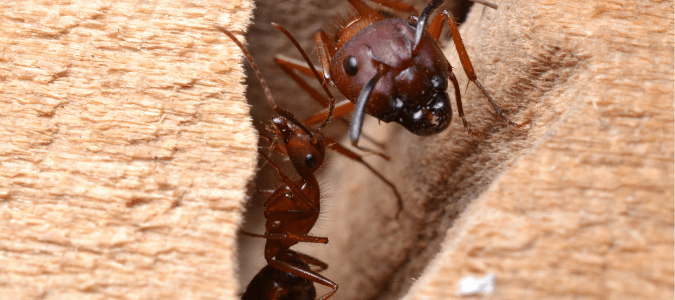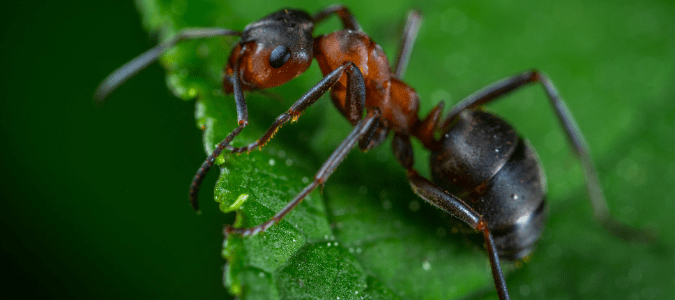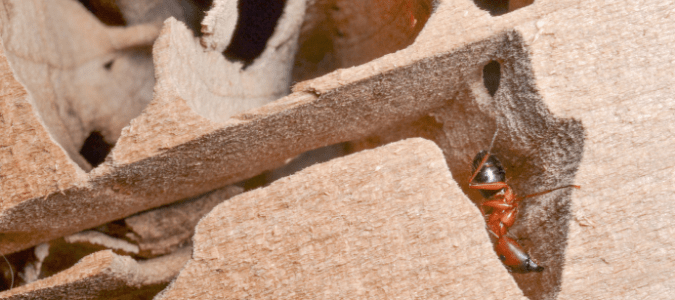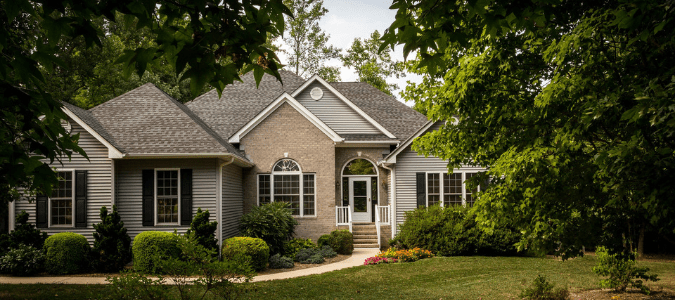
Carpenter ant bites can be a big pain—quite literally. A bite on human skin looks like a pea-sized blemish, and the aftermath may feel like a strong pinch or even a quick burn on the skin. This is because when carpenter ants bite, these insects spray formic acid onto their victim. Formic acid isn’t necessarily dangerous to humans, but it does increase the intensity of the pain you feel. You can reduce the pain associated with a carpenter ant bite by washing the impacted area with soap and water right away. Doing so will flush away the formic acid that causes pain to the area, which should cause the discomfort to recede. If not, a cold compress or ice should help to soothe the bite site.
Don’t be surprised if a carpenter ant bite draws blood. These insects are equipped with really strong jaws to chew through wood to make nests. If the bite does break through the skin, treat the area with an antibiotic ointment. If you tend to itch at bites, apply a bandage, as exposing even a small cut to the elements could increase your risk of infection.
Pain and other symptoms should go away within a day or two. If you continue to experience a burning feeling, talk to a doctor.
Luckily, this is the extent of the damage these ants inflict on our bodies. While that might be a bit of a relief, you should know that carpenter ants are one of the most common ant species that can infest homes and damage wood, and that these ants are among the most difficult species to control. In this post, we cover the most important things homeowners need to know about these pests, including how to get rid of them and what could happen if you have an infestation.
Let’s start by making sure it’s carpenter ants you’re dealing with and not another type of insect.

What Do Carpenter Ants Look Like?
In order to implement a successful strategy to control carpenter ants, you’ll need to make sure that you do indeed have this type of ant inside. Why? Different ant species require different methods of treatment.
Carpenter ants are typically only about a half-inch long, but they tend to be larger than other species of ants, including fire ants. Some carpenter ants can even grow to be an inch long—certainly not a welcome sight when you spot one in your home.
Carpenter ants can be red, black or a combination of the two, although typically Texas carpenter ants have a black body and a red head and chest area. These insects have six legs, crooked antenna and can have wings. Carpenter ants are nocturnal, so you may see them more frequently as you’re getting ready to head to bed.
When trying to identify carpenter ants, homeowners most commonly confuse these creatures termites. So, how can you tell the two apart?
Carpenter Ants Vs. Termites
Homeowners mix these two insects up frequently because they are a similar color, both develop wings and the two species are both notorious for destroying the wood in your home. A pest professional will tell you that to get rid of carpenter ants and to get rid of swarming termites require different tactics.
The biggest physical difference between carpenter ants and termites is the size and shape of their body. Carpenter ants have a distinct thorax and abdomen with a shape like an hourglass. If you were to hold a dime up next to an ant, you’ll find the ant is a bit larger. In contrast, a termite’s thorax and abdomen tend to blend together and they are a bit smaller in size. Both ants and termites swarm during the springtime, so to the untrained eye, these two insects may look the most alike. To be on the safe side, you’re better off calling in a pest control professional to identify the insect you are seeing so you are better informed as to what steps to take next.
If you have determined that you have a carpenter ant infestation and not a termite problem, you still need to be concerned, as these pests can damage to your home.

Carpenter Ant Damage—Why You Should Be Proactive
Homeowners, unfortunately, have more worries when it comes to these nasty critters than just their stinging bite. Even though carpenter ants don’t eat wood, they can still cause damage to your wooden furniture or even the framing in your house by burrowing through it to create nests. If you ever had an ant farm, you know these nests aren’t just a small, simple space—nests include tunnels, big holes and intricate routes that ants navigate every day.
These tunnels and other holes in the wood of your home can eventually weaken its structural integrity. If carpenter ants get into the framing that holds your house up, you could face serious—and expensive—problems. By eliminating a carpenter ant population, you safeguard your biggest investment, saving you money down the line if you want to renovate, make repairs or sell your home.
You can make your property less attractive to these pests by:
- Repairing leaks in your plumbing, roof and other areas where moisture could collect that could provide the ants with a water source.
- Reduce or eliminate wood-to-ground contact where soil or mulch is touching your wood siding.
- Trim tree branches and vegetation so it does not touch your roof and provide a pathway for ants to climb onto your living structure.
- Close any holes or cracks in your foundation. Pay particular attention to where wiring and pipes enter your home.
- Elevate any firewood off the ground and stack this firewood away from your home’s foundation. Avoid storing this wood in your garage or inside your home, since this is an ideal nesting area for carpenter ants.
If carpenter ants are nocturnal, making it less likely the average homeowner will see them, are there other giveaways that you can look out for to protect your home?

Signs Of Carpenter Ants In Houses
As carpenter ants begin to establish a nest, they’ll chew through wood and leave little piles of sawdust. If you start to see small fragments of wood appearing near rotting trees or around the foundation of your home, you’ve most likely got carpenter ants setting up shop.
If you see just one carpenter ant, and assume you don’t have a problem, you might be making a big mistake. That’s because when carpenter ants set up nests, they send out worker ants to survey the area. These scouts may be operating independently, but still serve as an indication that thousands of other insects could be elsewhere on your property.
Spotting winged ants are an even more ominous sign of an infestation. These reproductives may confirm that nests have already been established and that the ants are getting ready to expand their colony even further.
Unfortunately, a carpenter ant infestation can get even worse. In severe cases, these ants will eat through enough wood that it damages or warps the framing of your home. Signs of warped framing and damaged wood include doors and windows that appear stuck or ceilings and walls that don’t appear to be holding up right. At this point, you really need to call in the professionals.
With their natural instinct being to chew through wood, you may be wondering why these insects are biting us in the first place.
Why Humans Get Bitten By Carpenter Ants
Carpenter ants are very similar to the notorious fire ant, but there are a few important distinctions to make between the two pests. One of the most important differences is the reason these creatures bite.
Carpenter ants attack when they feel threatened by humans or other creatures, including our pets. If you leave these ants alone, they will leave you alone. But once you try to squash them or pick one up to remove it, you run the risk of getting bitten.
The only other reason a carpenter ant would attack is if you have threatened the nest. This scenario is even more dangerous, because it usually means not just one carpenter ant will be going after you, but a whole group.
While you may try to avoid these ants, these insects can be so small that sometimes you don’t realize what you have done until it is too late. For example, a backyard game of catch can end in a number of bites if someone accidentally runs into a carpenter ant hill.
After being on the receiving end of one too many bites or any damage to your home, you’re ready for these pests to be gone.

How To Get Rid Of Carpenter Ants
Many homeowners ask us, does baking soda kill ants?
Well quite frankly, there is no one solution to getting rid of carpenter ants. The first step to managing a carpenter ant problem is looking indoors, outdoors and within your walls for signs of a nest, since finding the nest will be the best way to eliminate multiple ants at once. If you find the nest, you can try using an insecticide spray yourself. This can be extremely dangerous, since carpenter ants will attack if they sense their home is in danger, which could leave you covered in bites.
If you can’t find the nest, your best bet is using a bait to enlist ants to bring targeted treatments back to the colony. Keep in mind, it’s going to take some time for your populations to start to dwindle, as this bait will only kill a small number of ants at a time. Unfortunately, your carpenter ant problem will continue until a nest is found and treated.
If you’re looking for a treatment plan with guaranteed results and no work on your end, it might be time to bring in someone with experience.
ABC Can Resolve Your Ant Problem
Carpenter ants can be a nuisance at best and a very expensive problem at worst. If you really want to determine the best course of action and get started preventing the further spread of carpenter ant damage, your best course of action is to call in a pest professional. The team at ABC Home & Commercial Services has extensive experience dealing with all types of insect invaders, and can help you address any pest problems throughout your property. After our initial consultation, we can work with you to create a comprehensive maintenance and treatment plan that targets your current problem and prevents any pests from attacking your family or your house in the future.